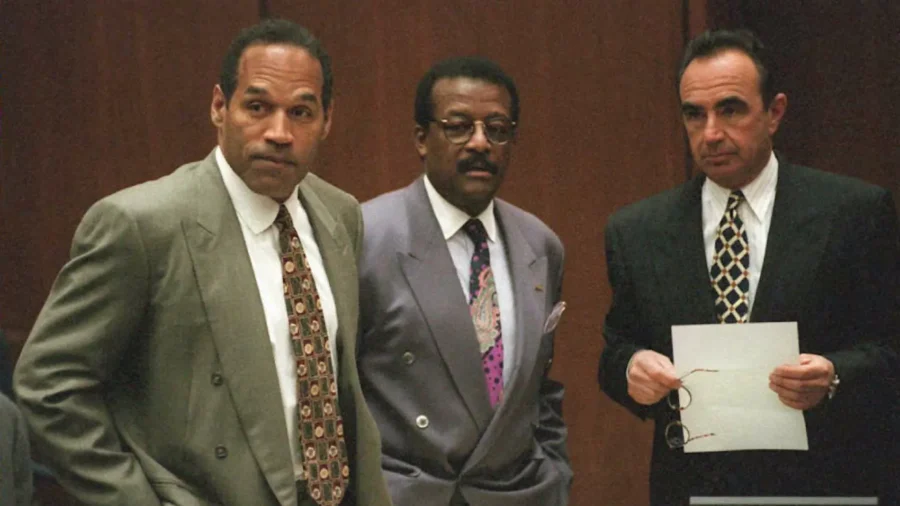In June of 1994, Nicole Brown Simpson and her friend Ron Goldman were found stabbed to death outside of her townhouse in the upscale neighborhood of Brentwood, California. Ms. Simpson was the ex-wife of former football star and actor OJ Simpson. Mr. Simpson and Ms. Simpson were married for seven years until their divorce, roughly 18 months before her murder.
Mr. Simpson became a person of interest shortly after the bodies were discovered.
Ordered by prosecutors to surrender, Mr. Simpson, equipped with a passport and donning a disguise, opted to flee on the day in question, accompanied by his friend and former teammate Al Cowlings in a white Ford Bronco.
The image of a white Ford Bronco, helmed by Mr. Cowlings and transporting Mr. Simpson, trailed by Los Angeles police on June 17, 1994, etched itself into the collective memory as the vehicle embarked on a televised odyssey across California freeways, shadowed by a police pursuit broadcast to an estimated 95 million viewers nationwide. Hundreds of onlookers and fans convened on freeway overpasses, some holding signs reading “Go OJ!”
In a tense phone call to law enforcement, Mr. Cowlings disclosed that Mr. Simpson lay in the rear seat of the vehicle, clutching a firearm to his temple. Eventually arriving at his Brentwood residence, Mr. Simpson was persuaded to surrender.
Dubbed the “trial of the century,” the proceedings began on Jan. 24, 1995, with prosecutors asserting Mr. Simpson’s guilt and presenting forensic evidence linking him to the crime.
Americans found themselves ensnared by a singular news saga, forsaking scripted dramas and soap operas for the spectacle of trial developments, as recounted by Entertainment Weekly on Oct. 13, 1995.
Magazines such as TIME delved into profiles of the trial’s key players—officers, attorneys, and peripheral figures—whose ascent to celebrity status was unprecedented. The omnipresent gaze of Court TV and CNN documented every facet of the legal proceedings over a staggering 16-month period, fostering a collective engagement unparalleled in its intensity.
As the trial reached its climactic verdict, broadcast live from the courtroom, it catalyzed an insatiable appetite for the burgeoning 24-hour news cycle and laid the groundwork for the explosive rise of reality television. Little could anyone have predicted the profound impact that one courtroom luminary, Robert Kardashian, would have on the landscape of entertainment in the years to come.
Yet, disparate perspectives emerged amidst the shared spectacle televised nationwide.
The trial ignited debates about race in America, intensifying in the wake of the verdict. TIME found itself embroiled in controversy when its decision to darken Mr. Simpson’s mugshot for the cover following the car chase sparked an outcry. Managing editor James R. Gaines, reflecting on the backlash, conceded, “I have never been so wrong about how one would be received.”
The aftermath of the trial laid bare a nation divided along racial fault lines, with some viewing Mr. Simpson as yet another victim of systemic injustice, while others castigated the predominantly black jury for what they saw as a miscarriage of justice.
Amidst the legal proceedings, punctuated by delays orchestrated by the accommodating Judge Lance Ito, the presence of legal expert Prof. Gary Solis provided invaluable guidance, elucidating the intricacies of the Californian legal system to a puzzled audience.
As the trial unfolded, the courtroom protagonists emerged: Marcia Clark and Christopher Darden for the prosecution, countered by the formidable “Dream Team” of defense attorneys including Jonnie Cochran, F. Lee Bailey, Alan Dershowitz, and Robert Kardashian.
Beyond the courtroom theatrics lay the narrative of two lives extinguished in a brutal act, their families left grappling with immeasurable loss. A pivotal moment occurred on June 15, 1995, as Simpson struggled to don a pair of gloves in a dramatic courtroom demonstration, prompting Mr. Cochran’s memorable refrain, “If it doesn’t fit, you must acquit.”
On Oct. 3, 1995, the trial reached its denouement with a verdict of not guilty, as Mr. Simpson, maintaining his innocence throughout, expressed gratitude to the jurors as he was acquitted on all of the charges.
Mr. Simpson died of cancer on April 10 in Las Vegas. He was 76 years of age.
From The Epoch Times


